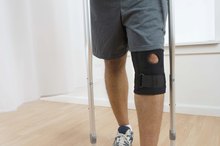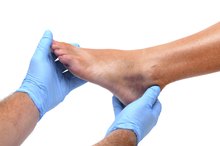Vastus Lateralis & Muscle Strain
The vastus lateralis is one of four muscles that make up the quadriceps. These muscles work together to extend the knee. The vastus lateralis is located above the knee joint, toward the outer edge of the leg. It lies beneath the iliotibial tract, which is a band of fascia that runs vertically along the outer thigh. The vastus lateralis is susceptible to muscle fiber tearing -- which is called a muscle strain -- through knee extension in sports and everyday activities.
Classification of Muscle Strains
The severity of the muscle strain is measured by the damage to the muscle and the amount of blood drawn to the injury site. Strains are typically classified as either first-degree, second-degree or third-degree. A first-degree strain is considered mild because only a few muscle fibers are torn, swelling is minimal and little discomfort is associated with this type of injury. A second-degree strain is considered moderate because a greater number of fibers are torn and leg function is somewhat compromised. A third-degree strain is the most severe. The entire muscle is torn, resulting in a complete loss of leg function.
- The severity of the muscle strain is measured by the damage to the muscle and the amount of blood drawn to the injury site.
- A second-degree strain is considered moderate because a greater number of fibers are torn and leg function is somewhat compromised.
Immediate Treatment
Does Jogging Help Strengthen the MCL?
Learn More
Long-term treatment options vary depending on the severity of the injury. However, immediate treatment with a first-, second- or third-degree strain of the vastus lateralis remains the same. Immediately apply crushed ice to the outer thigh area, gently compress the ice with a tensor bandage and elevate the thigh above the heart to reduce swelling. Prior to any other treatment, consult a physician for optimal recovery.
- Long-term treatment options vary depending on the severity of the injury.
- Prior to any other treatment, consult a physician for optimal recovery.
The Healing Process
The healing of skeletal muscle tissue follows a process similar to that of the healing of cuts and bruises. The tissue goes through three major phases: destruction phase, repair phase and remodeling phase. Throughout these phases, the body slowly repairs the torn muscle fibers. The length of time for the healing process to occur depends on the severity of the injury, the immediate treatment performed and the individual's general health. Typically a vastus lateralis strain requires anywhere from three weeks to six months to heal.
- The healing of skeletal muscle tissue follows a process similar to that of the healing of cuts and bruises.
- Throughout these phases, the body slowly repairs the torn muscle fibers.
Rehabilitation Considerations
Torn Tendons & Ligaments From Hyperextension
Learn More
Following immediate treatment and an assessment by a medical professional, exercise rehabilitation is an effective long-term treatment option. However, there are a few things to consider. A portion of the femoral nerve runs through the vastus lateralis, so a rehabilitation specialist works to prevent any nerve impingement during the healing process. In addition, an important component of a successful recovery is maintenance of general health. Despite the vastus lateralis injury, continue with upper body cardiovascular activity and proper nutrition.
- Following immediate treatment and an assessment by a medical professional, exercise rehabilitation is an effective long-term treatment option.
- In addition, an important component of a successful recovery is maintenance of general health.
Related Articles
References
- Trail Guide to the Body; Andrew Biel
- Muscles; Florence Peterson Kendall
- Skeletal Muscle Repair and Regeneration; Stefano Schiaffino and Terence Partridge
- Sports Medicine Essentials; Jim Clover
- Postsurgical Orthopedic Sports Rehabilitation; Postsurgical Soft Tissue Healing; Michelle M. Lesperance et al.
- Cavazzuti L, Merlo A, Orlandi F, Campanini I. Delayed onset of electromyographic activity of vastus medialis obliquus relative to vastus lateralis in subjects with patellofemoral pain syndrome. Gait Posture. 2010;32(3):290-5.
- Cavazzuti L, Merlo A, Orlandi F, Campanini I. Delayed onset of electromyographic activity of vastus medialis obliquus relative to vastus lateralis in subjects with patellofemoral pain syndrome. Gait Posture. 2010;32(3):290-5. doi:10.1016/j.gaitpost.2010.06.025
- Staron RS, Hagerman FC, Hikida RS, et al. Fiber type composition of the vastus lateralis muscle of young men and women. J Histochem Cytochem. 2000;48(5):623-9. doi:10.1177/002215540004800506
Writer Bio
Erika McAuley is a freelance writer from Abbotsford, British Columbia. As an exercise rehabilitation professional, she has been preventing and treating musculoskeletal injuries in athletes and civil workers since 2008. McAuley holds a Bachelor of Human Kinetics in athletic therapy from Trinity Western University and an Advanced Certificate in Athletic Therapy from Mount Royal University.









